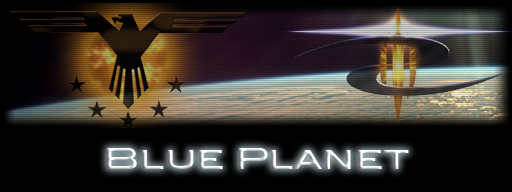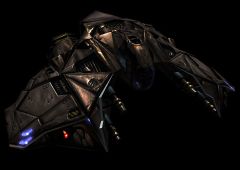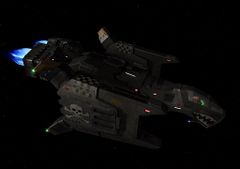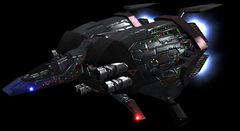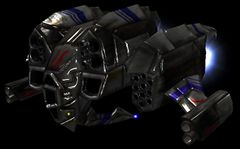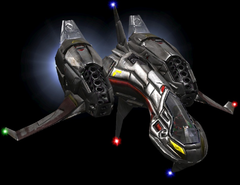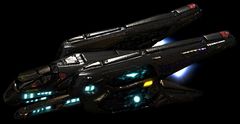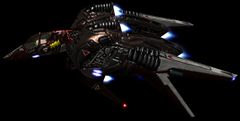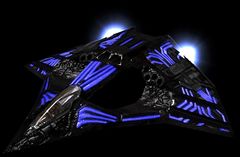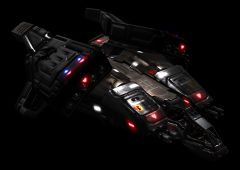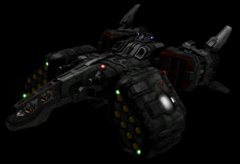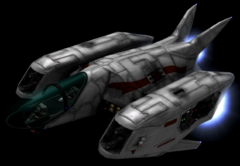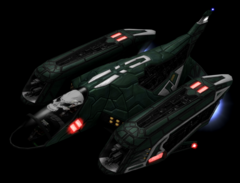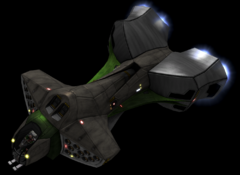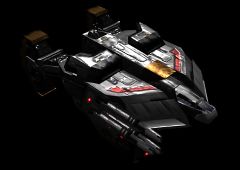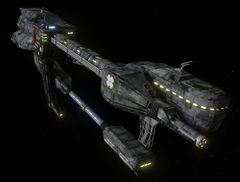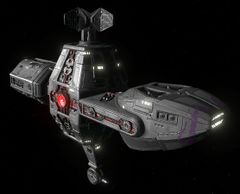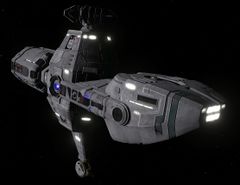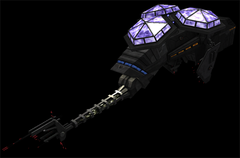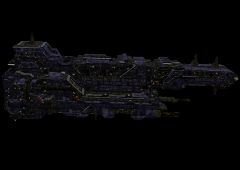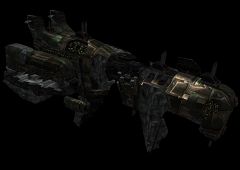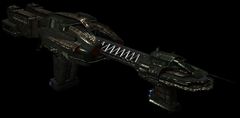Difference between revisions of "Blue Planet ships data"
m |
MatthTheGeek (talk | contribs) (MOAR) |
||
| Line 23: | Line 23: | ||
{{comment| The Ulysses is notably used in one occasion by the [[Gaian Effort]]'s Kostadin cell, as part of a semi-hidden, semi-bonus gauntlet. They use the callsign "Kostadin Habitat Guard", sport the Balls of Steele AI, are armed with [[Balor]], [[Vulcan]] and [[Dart]], and are part of a wing with 55 waves also comprising a couple of similarly-equipped [[Scimitar (Blue Planet)|Scimitar]], and escorting a [[GEC Ancamna]] gunship.}} | {{comment| The Ulysses is notably used in one occasion by the [[Gaian Effort]]'s Kostadin cell, as part of a semi-hidden, semi-bonus gauntlet. They use the callsign "Kostadin Habitat Guard", sport the Balls of Steele AI, are armed with [[Balor]], [[Vulcan]] and [[Dart]], and are part of a wing with 55 waves also comprising a couple of similarly-equipped [[Scimitar (Blue Planet)|Scimitar]], and escorting a [[GEC Ancamna]] gunship.}} | ||
| + | |||
| + | [[Image:Gtfloki.jpg|thumb|right|240px]] | ||
| + | ===[[GTF Loki]]=== | ||
| + | The linchpin of GTI fighter forces during Rybak's Hades Rebellion was the Loki stealth fighter. Initially an invisible nightmare, the Loki lost its main tactical advantage when a weakness in its stealth systems was discovered. It was moved into the role of scout fighter during Reconstruction, but was often pressed into the dogfight and intercept role by the Neo-Terran Front, where it earned praise for its agility but struggled to compensate for its structural weakness. The Loki has not been produced since the NTF Rebellion, and most remaining spaceframes have been sold off. | ||
| + | |||
| + | |||
| + | |||
| + | |||
| + | |||
| + | |||
| + | |||
| + | |||
| + | |||
| + | |||
| + | {{comment| }} | ||
[[Image:Gtfhercules.jpg|thumb|right|240px]] | [[Image:Gtfhercules.jpg|thumb|right|240px]] | ||
| Line 40: | Line 55: | ||
{{comment|}} | {{comment|}} | ||
| − | [[Image: | + | |
| − | ===[[GTF | + | [[Image:Gtfmyrmidon.jpg|thumb|right|240px]] |
| − | The | + | ===[[GTF Myrmidon]]=== |
| + | The Myrmidon fighter, designed by RNI Systems to fulfill an impossibly broad request from the Admiralty, is a space superiority fighter with problematic handling, the primary firepower of an assault craft, and three secondary banks of unusual design and limited capacity. It is gradually being phased out, but still serves as a line fighter, bomber escort, and battle group guardian across the Terran elements of the Alliance fleet. Some pilots achieve a particular affinity with this unusual craft, but in general its wide target profile has given it a reputation as a pilot-killer. Captured Neo-Terran Front pilots reported that the Myrmidon was respected for its firepower but considered too clumsy for its role. | ||
| + | |||
| + | |||
| + | |||
| + | |||
| + | |||
| + | |||
| + | |||
| + | |||
| + | |||
| + | |||
| + | |||
| + | {{comment| Do NOT be intimidated at how cheap and vulnerable this ship is, a 4x Balor and Tornado racks can easily ruin your day.}} | ||
| + | |||
| + | [[Image:Perseus 12 w14 lighting.png|thumb|right|240px]] | ||
| + | ===[[GTF Perseus]]=== | ||
| + | The mainstay of the Terran fleet after the Second Incursion, the Perseus is produced on nearly every world in the Alliance and assigned to every destroyer in every battle group. Reassigned from intercept to multirole combatant after its sterling performance during the Second Incursion, the Perseus is cheap, flexible, and an excellent dogfighter and interceptor. In a pinch it can perform anti-subsystem strikes on warships with Stiletto II bombs. Even with the advent of next-generation fighters, the Perseus will remain in service for years to come. | ||
| + | |||
| Line 52: | Line 85: | ||
| + | {{comment| Armed with a Balor and the Prometheus Standard, these fighters are one of the few that actually hold a candle against UEF ships. They typically have Harpoons and/or Trebuchets. Expect at least one wing of them to be in your operations zone.}} | ||
| + | |||
| + | [[Image:Gtfherculesmarkii.jpg|thumb|right|240px]] | ||
| + | ===[[GTF Hercules Mark II]]=== | ||
| + | The Hercules II assault fighter sacrifices some of its predecessor's cannon firepower for a boost in secondary capacity. The modernized, hybrid spaceframe offers enhanced ordnance bays and a sophisticated fire control computer. The Hercules II performed well during its OpEval period and, despite casualties during the Second Shivan Incursion, was judged a success in its assigned role attacking lightly defended targets and cruisers. However, the introduction of the Ares spaceframe, a modified Hercules II, has limited Hercules II deployment in the true heavy assault role. Hercules II fighters are used as skirmishers against lightly defended convoys, and as heavy missile pickets on escort missions. | ||
| − | |||
| − | |||
| − | |||
| − | |||
| Line 66: | Line 100: | ||
| − | {{comment| | + | {{comment| These ships are almost always on the scene rigging Maxim strikes at long range, making them a priority. The other massive threat they pose is with their swarm missiles, which can do a number on cruisers and frigates.}} |
[[Image:Gtferinyes.jpg|thumb|right|240px]] | [[Image:Gtferinyes.jpg|thumb|right|240px]] | ||
| Line 82: | Line 116: | ||
{{comment| In [[My Brother, My Enemy]], the Erinyes fighters you see are equipped with UD-8 Kaysers, often being the main source of frustration for that mission. Once you have access to the Rapier, these fighters are relatively easy to cut through.}} | {{comment| In [[My Brother, My Enemy]], the Erinyes fighters you see are equipped with UD-8 Kaysers, often being the main source of frustration for that mission. Once you have access to the Rapier, these fighters are relatively easy to cut through.}} | ||
| − | |||
| − | |||
| − | |||
| + | [[Image:Gtfares.jpg|thumb|right|240px]] | ||
| + | ===[[GTF Ares]]=== | ||
| + | The Ares was the result of a crash program to rebuild the Hercules Mark 2 as a heavily armored missile boat. Slower and clumsier than its base model, the Ares mounts depleted uranium armor plating over critical subsystems, molybdenum plates, and enhanced shields. It can carry sufficient [[Trebuchet]] missiles to disarm a light warship or fend off multiple bomber wings before rearming. The Ares entered service just as the Shivans stormed Capella, and what few units were available saved thousands of lives during escort missions. Despite a stormy production history, the Ares is now a front-line combatant, used in heavy assault missions, pop-up [[Trebuchet]] strikes, and critical defensive missions. Despite its usefulness as a missile platform, it cannot dogfight effectively, and must avoid interceptors at all costs. | ||
| Line 94: | Line 128: | ||
| − | + | {{comment| The few times you see the Ares, they will be launching plot-critical Trebuchet attacks against you or wings you need to defend. Missiles are a surefire way to bring them down.}} | |
| − | {{comment| }} | ||
[[Image:Gtfpegasus.jpg|thumb|right|240px]] | [[Image:Gtfpegasus.jpg|thumb|right|240px]] | ||
| Line 112: | Line 145: | ||
{{comment| Note that the Pegasii used in [[Deals in Shadows]] are force-mounted with [[Maxim]] guns through the mission file, even though they would normally be incapable of equipping them.}} | {{comment| Note that the Pegasii used in [[Deals in Shadows]] are force-mounted with [[Maxim]] guns through the mission file, even though they would normally be incapable of equipping them.}} | ||
| − | [[Image: | + | [[Image:Gtbzeus.jpg|thumb|right|240px]] |
| − | ===[[ | + | ===[[GTB Zeus]]=== |
| − | The | + | The Zeus was a GTI tactical bomber, designed for light anti-shipping work and as a tactical missile platform. For nearly twelve years after the Second Incursion, the Zeus actually remained in production to serve as a stopgap Trebuchet delivery system, as well as in its historical role carrying light warheads like the Stiletto II. The Zeus now serves as a training target and has been largely removed from service. |
| + | |||
| + | |||
| + | |||
| Line 124: | Line 160: | ||
| + | {{comment| }} | ||
| − | + | [[Image:GTBMedusa.png|thumb|right|240px]] | |
| + | ===[[GTB Medusa]]=== | ||
| + | The Medusa is an obsolete Great War-era bomber. It was used in an anti-shipping role by the Neo-Terran Front, but never met with any real success. GTVA pilots considered the Medusa an ineffective deathtrap. | ||
| − | |||
| − | |||
| − | |||
| Line 141: | Line 177: | ||
| − | {{comment| | + | {{comment| }} |
[[Image:GTBArtemis.png|thumb|right|240px]] | [[Image:GTBArtemis.png|thumb|right|240px]] | ||
| Line 190: | Line 226: | ||
{{comment| Anti-shield weapons are your best bet at bringing the Boanerges down, then their armor can be easily torn apart by missiles. They tend to launch dual Cyclops torpedoes, or even the Helios. If all else fails, a Grimler or a Slammer works.}} | {{comment| Anti-shield weapons are your best bet at bringing the Boanerges down, then their armor can be easily torn apart by missiles. They tend to launch dual Cyclops torpedoes, or even the Helios. If all else fails, a Grimler or a Slammer works.}} | ||
| − | [[Image: | + | [[Image:Gtbursa.jpg|thumb|right|240px]] |
| − | ===[[GTB | + | ===[[GTB Ursa]]=== |
| − | + | Fifty years after the Great War, the Ursa bomber still serves the GTVA as an inflexible but powerful anti-shipping platform. With limited speed, the Ursa struggles to reach its targets, and in spite of heavy armor it cannot survive engagement with even a single interceptor. Its large target profile renders it vulnerable to flak and beam fire. Tactical doctrine calls for Ursa deployment against destroyers after their antifighter defenses are disarmed and their fighter compliment depleted. Designers today consider the Ursa a dead end, and strive to manufacture bombers with fighter-like maneuverability and speed. | |
| + | |||
| + | |||
| + | |||
| + | |||
| + | |||
| + | |||
| + | |||
| + | |||
| + | |||
| + | |||
| + | {{comment| }} | ||
| + | |||
| + | [[Image:Gtmhippocrates.jpg|thumb|right|240px]] | ||
| + | ===[[GTM Hippocrates]]=== | ||
| + | The Hippocrates medical ship is built in multiple, easily isolated compartments in case of disease outbreak. These vessels are amongst the GTVA's most important, traveling from system to system to provide disaster relief and specialized medical facilities. The Hippocrates can carry thousands of patients, and as such, the Block 2 upgrade provided it with some defense: anti-fighter weapons and even a light beam cannon. However, only the most desperate of circumstances would necessitate their use. | ||
| + | |||
| + | |||
| + | |||
| + | |||
| + | |||
| + | |||
| + | |||
| + | |||
| + | |||
| + | |||
| + | |||
| + | {{comment| }} | ||
| + | |||
| + | [[Image:Gtcfenris.jpg|thumb|right|240px]] | ||
| + | ===[[GTC Fenris]]=== | ||
| + | The Fenris was never a successful warship design. Too lightly armored to withstand assault fighter attacks, unable to meaningfully engage other warships even after upgraded with beam weapons, and bogged down by inefficient reactors and an obsolete spaceframe, the Fenris is now used solely as a target or a patrol cruiser. Cramped quarters and an inflated crew count due to obsolete automation make posting to a Fenris into a punishment detail. | ||
| + | |||
| + | |||
| + | |||
| + | |||
| + | |||
| + | |||
| + | |||
| + | |||
| + | |||
| + | |||
| + | |||
| + | |||
| + | {{comment| }} | ||
| + | |||
| + | [[Image:Gtcleviathan.jpg|thumb|right|240px]] | ||
| + | ===[[GTC Leviathan]]=== | ||
| + | Unlike its cousin the Fenris, with which it shares a spaceframe, the Leviathan remains in limited use in some battle groups as a destroyer defense picket. It is useless against modern warships, but its four Phalanx anti-fighter systems give it respectable deterrent ability. Painfully slow both in realspace and in terms of subspace agility, the Leviathan is a crude, inefficient, and largely obsolete warship. | ||
| + | |||
| Line 207: | Line 292: | ||
{{comment| }} | {{comment| }} | ||
| − | [[Image: | + | [[Image:GTA-Charybdis.png|thumb|right|240px]] |
| − | ===[[ | + | ===[[GTA Charybdis]]=== |
| − | + | The Charybdis Advanced Warning and Control System is a fragile but extraordinarily useful piece of technology. Capable of calculating and rapidly relaying precise subspace jump coordinates, it enable GTVA fighters and bombers to approach their targets at optimal range. It can also perform blanket communications jamming, selectively block aspect lock on itself or friendly warships, or grant itself or nearby vessels limited stealth. OpEval equipment permits it to generate EMP blasts or to guide subspace missile strikes to their targets. | |
| + | |||
| + | |||
| + | |||
| + | |||
| + | |||
| + | |||
| + | |||
| + | |||
| + | |||
| + | |||
| + | |||
| + | {{comment| ''Canonical AWACS roles include plotting precise jumps coordinates, jamming communications, jamming torpedo lock, and setting up SSM strikes without the need for a TAG link. They're often mission-critical targets, but are vulnerable enough on their own that a single UEF fighter could easily destroy them or force them to retreat.''}} | ||
| + | |||
| + | [[Image:Gtdorion.jpg|thumb|right|240px]] | ||
| + | ===[[GTD Orion]]=== | ||
| + | The magnificent Orion destroyer was the GTVA's heaviest line combatant in the Second Incursion, complimenting the Hecate-class carriers. With the new Raynor class entering service, the Orion has at last found a worthy successor, and its five-decade career is nearing an end. Some Orions remain in service, including the storied [[GTD Carthage (BP)|GTD Carthage]], now a Combat Evaluation Destroyer with modified jump drives. | ||
| + | |||
| + | |||
| + | |||
| Line 222: | Line 326: | ||
{{comment| }} | {{comment| }} | ||
| − | [[Image: | + | [[Image:Gtdhecate.jpg|thumb|right|240px]] |
| − | ===[[ | + | ===[[GTD Hecate]]=== |
| − | The | + | The Hecate carrier was designed for rapid, efficient fighter operations rather than direct combat. The Second Shivan Incursion proved the value of this strategy, but also highlighted its flaws. Whenever Hecate-class destroyers found themselves in direct combat with hostile warships, they failed to perform. The Hecate now makes up the bulk of the GTVA's destroyer fleet, and, in line with current fighter-heavy strategic doctrine, serves as a rear-area base for strike craft operations. Hecate destroyers never enter combat without their battlegroups. Superior fighter capacity and an excellent flight deck make the Hecate an extraordinarily flexible power projection system, and this ability is at the center of the GTVA's planning for future Shivan threats. |
| + | |||
| + | |||
| + | |||
| + | |||
| + | |||
| + | |||
| + | |||
| + | |||
| + | |||
| + | |||
| + | |||
| + | {{comment| The Hecate, usually re-designated as a carrier in the BP lore, is the most numerous destroyer-class ship available to the Tevs. Unfortunately for them, it is just as vulnerable to warship assaults as it was during the Second Shivan Incursion. Fortunately for them, warship assaults aren't exactly the specialty of the UEF. With reinforced beam dish armor, an easily-overcharged frontal [[BGreen|Crypt Hammer]], EW capabilities and a full hangar of trained GTVA pilots, the Hecate is not exactly an easy prey. That doesn't mean, however, that a Hecate should cruise without the support of its battlegroup, or be deployed as an attack warship - as [[Post Meridian]] showed, a couple of well-prepared [[UEFg Karuna|Karunae]] with sufficient fighter support are enough to do a number to it. The Hecate is still significantly outmatched on nearly every point by the newer [[Raynor]] and [[GTD Titan|Titan]].}} | ||
| + | [[Image:Gtvacolossus.jpg|thumb|right|240px]] | ||
| + | ===[[GTVA Colossus]]=== | ||
| + | Thirty thousand of the GTVA's finest, Terran and Vasudan alike, died aboard the GTVA Colossus when it was destroyed by a single Sathanas juggernaught in Capella. Twenty years of effort, along with all the pride and propaganda bound up in the massive warship, were lost in a mere twenty seconds. After this tragedy, GTVA warship design steered away from massive superships and towards more flexible advanced destroyers. In spite of frequent rumours, no plans to build a fleet of Colossus warships have ever been suggested. | ||
| Line 238: | Line 357: | ||
{{comment| }} | {{comment| }} | ||
| + | |||
{{stub}} | {{stub}} | ||
Revision as of 10:38, 12 September 2012
| The following information has not been confirmed by Volition and is therefore not canon for the FreeSpace universe. |
|---|
This page references tech room entries and veteran comments for BP ships that do not have their own BP-specific page, typically retail ships.
Back to Blue Planet Tech Room data.
Contents
- 1 GTVA Terran ships
- 1.1 GTF Ulysses
- 1.2 GTF Loki
- 1.3 GTF Hercules
- 1.4 GTF Myrmidon
- 1.5 GTF Perseus
- 1.6 GTF Hercules Mark II
- 1.7 GTF Erinyes
- 1.8 GTF Ares
- 1.9 GTF Pegasus
- 1.10 GTB Zeus
- 1.11 GTB Medusa
- 1.12 GTB Artemis
- 1.13 GTB Artemis D.H.
- 1.14 GTB Boanerges
- 1.15 GTB Ursa
- 1.16 GTM Hippocrates
- 1.17 GTC Fenris
- 1.18 GTC Leviathan
- 1.19 GTA Charybdis
- 1.20 GTD Orion
- 1.21 GTD Hecate
- 1.22 GTVA Colossus
GTVA Terran ships
GTF Ulysses
A product of joint Terran-Vasudan design, the Ulysses is a Great War-era light space superiority fighter renowned for its maneuverability and slim target profile. It saw limited action during the Second Shivan Incursion, serving on front-line units with the Neo-Terran Front and as a combat evaluation fighter with the GTVA. The Ulysses remains in very limited production, but has been completely retired from front-line GTVA formations.
GTF Loki
The linchpin of GTI fighter forces during Rybak's Hades Rebellion was the Loki stealth fighter. Initially an invisible nightmare, the Loki lost its main tactical advantage when a weakness in its stealth systems was discovered. It was moved into the role of scout fighter during Reconstruction, but was often pressed into the dogfight and intercept role by the Neo-Terran Front, where it earned praise for its agility but struggled to compensate for its structural weakness. The Loki has not been produced since the NTF Rebellion, and most remaining spaceframes have been sold off.
GTF Hercules
The Hercules assault fighter was the crowning jewel of Allied fighter forces during the Great War, and it remained a favorite amongst pilots even after the introduction of its successor, the Hercules II. Many Hercules units were lost during the NTF rebellion. The Hercules has been pulled from front-line service, and production has been discontinued. Remaining spaceframes serve as targets or in security operations.
GTF Myrmidon
The Myrmidon fighter, designed by RNI Systems to fulfill an impossibly broad request from the Admiralty, is a space superiority fighter with problematic handling, the primary firepower of an assault craft, and three secondary banks of unusual design and limited capacity. It is gradually being phased out, but still serves as a line fighter, bomber escort, and battle group guardian across the Terran elements of the Alliance fleet. Some pilots achieve a particular affinity with this unusual craft, but in general its wide target profile has given it a reputation as a pilot-killer. Captured Neo-Terran Front pilots reported that the Myrmidon was respected for its firepower but considered too clumsy for its role.
GTF Perseus
The mainstay of the Terran fleet after the Second Incursion, the Perseus is produced on nearly every world in the Alliance and assigned to every destroyer in every battle group. Reassigned from intercept to multirole combatant after its sterling performance during the Second Incursion, the Perseus is cheap, flexible, and an excellent dogfighter and interceptor. In a pinch it can perform anti-subsystem strikes on warships with Stiletto II bombs. Even with the advent of next-generation fighters, the Perseus will remain in service for years to come.
GTF Hercules Mark II
The Hercules II assault fighter sacrifices some of its predecessor's cannon firepower for a boost in secondary capacity. The modernized, hybrid spaceframe offers enhanced ordnance bays and a sophisticated fire control computer. The Hercules II performed well during its OpEval period and, despite casualties during the Second Shivan Incursion, was judged a success in its assigned role attacking lightly defended targets and cruisers. However, the introduction of the Ares spaceframe, a modified Hercules II, has limited Hercules II deployment in the true heavy assault role. Hercules II fighters are used as skirmishers against lightly defended convoys, and as heavy missile pickets on escort missions.
GTF Erinyes
The Erinyes had barely entered its OpEval period when the Second Shivan incursion began. It served with SOC units and, later, elite line squadrons, where it gained a reputation for massive firepower but low sustainability. Mounting the UD-8 Kayser probability weapon, the Erinyes' eight gun banks and good secondary capability give it tremendous killing power. But its reactor cannot handle the strain of sustained fire, and its maneuverability leaves something to be desired. Although it proved effective at massacring most Shivan fighters, and went into wide-scale production during the Threat Exigency Initiative, it remains an oddly paradoxical design - an excellent killer but a limited fighter. As agility became more and more critical to fighter design, the complex Erinyes proved impossible to re-engineer. Although it remains in service with elite squadrons for heavy space superiority missions, it will soon be superceded by the next-generation GTF Nyx.
GTF Ares
The Ares was the result of a crash program to rebuild the Hercules Mark 2 as a heavily armored missile boat. Slower and clumsier than its base model, the Ares mounts depleted uranium armor plating over critical subsystems, molybdenum plates, and enhanced shields. It can carry sufficient Trebuchet missiles to disarm a light warship or fend off multiple bomber wings before rearming. The Ares entered service just as the Shivans stormed Capella, and what few units were available saved thousands of lives during escort missions. Despite a stormy production history, the Ares is now a front-line combatant, used in heavy assault missions, pop-up Trebuchet strikes, and critical defensive missions. Despite its usefulness as a missile platform, it cannot dogfight effectively, and must avoid interceptors at all costs.
GTF Pegasus
The low-visibility, sensor-stealthed Pegasus fighter is a recon platform above all else. Operated primarily by Special Operations Command, Pegasus pilots work in pairs or alone, cruising for long cold hours or days without making telltale subspace jumps. The onboard sensor systems are adequate to the recon task, but limited by the need to maintain EMCON. Even when they must make subspace transits, Pegasus jump drives are difficult to detect or vector. Pegasus pilots gathered critical information that helped suppress brush wars after the Second Incursion, and allegedly performed deniable assassination missions.
GTB Zeus
The Zeus was a GTI tactical bomber, designed for light anti-shipping work and as a tactical missile platform. For nearly twelve years after the Second Incursion, the Zeus actually remained in production to serve as a stopgap Trebuchet delivery system, as well as in its historical role carrying light warheads like the Stiletto II. The Zeus now serves as a training target and has been largely removed from service.
GTB Medusa
The Medusa is an obsolete Great War-era bomber. It was used in an anti-shipping role by the Neo-Terran Front, but never met with any real success. GTVA pilots considered the Medusa an ineffective deathtrap.
GTB Artemis
Artemis bombers were not anticipated to be a success, but after a strong showing during the NTF rebellion, they now represent the majority of the GTVA's tactical strike ability. Maneuverable and cheap, the Artemis is able to deliver its payload rapidly. Tactical analysis suggested that bombers rarely survived prolonged engagement, so the Artemis' limited warhead capacity is considered non-problematic. Without defensive turrets, the Artemis is reliant on fighter escort, but it can dogfight if pressed. This behavior is strongly discouraged during pilot training, but because Artemis bombers are often deployed with inadequate escort, it frequently becomes necessary. The bomber's single primary bank is often fitted with a Maxim cannon for supplementary firepower.
GTB Artemis D.H.
A more maneuverable variant of the Artemis bomber, the Artemis DH has seen production alongside its white-skinned cousin. It is used in the same tactical role, targeting cruisers and corvettes.
GTB Boanerges
A controversial new heavy bomber at the time of the Second Shivan Incursion, the Boanerges proved a logistical dream but a mixed blessing tactically. Heavily shielded and with a large payload, the Boanerges eschewed defensive turrets as "of limited use." Bomber pilots did not react strongly to this decision, and although the Boanerges is at least capable in its role, it still divides pilots today. Good maneuverability allows the Boanerges some success in reaching its targets, but in spite of heavy armor cannot withstand defensive fire from warships or interceptors. It is an open question whether heavy bombers will remain tactically relevant. For the moment, the Boanerges' easy maintenance, cheap assembly, and long lifespan make it common in the heavy anti-shipping and anti-installation role.
GTB Ursa
Fifty years after the Great War, the Ursa bomber still serves the GTVA as an inflexible but powerful anti-shipping platform. With limited speed, the Ursa struggles to reach its targets, and in spite of heavy armor it cannot survive engagement with even a single interceptor. Its large target profile renders it vulnerable to flak and beam fire. Tactical doctrine calls for Ursa deployment against destroyers after their antifighter defenses are disarmed and their fighter compliment depleted. Designers today consider the Ursa a dead end, and strive to manufacture bombers with fighter-like maneuverability and speed.
GTM Hippocrates
The Hippocrates medical ship is built in multiple, easily isolated compartments in case of disease outbreak. These vessels are amongst the GTVA's most important, traveling from system to system to provide disaster relief and specialized medical facilities. The Hippocrates can carry thousands of patients, and as such, the Block 2 upgrade provided it with some defense: anti-fighter weapons and even a light beam cannon. However, only the most desperate of circumstances would necessitate their use.
GTC Fenris
The Fenris was never a successful warship design. Too lightly armored to withstand assault fighter attacks, unable to meaningfully engage other warships even after upgraded with beam weapons, and bogged down by inefficient reactors and an obsolete spaceframe, the Fenris is now used solely as a target or a patrol cruiser. Cramped quarters and an inflated crew count due to obsolete automation make posting to a Fenris into a punishment detail.
GTC Leviathan
Unlike its cousin the Fenris, with which it shares a spaceframe, the Leviathan remains in limited use in some battle groups as a destroyer defense picket. It is useless against modern warships, but its four Phalanx anti-fighter systems give it respectable deterrent ability. Painfully slow both in realspace and in terms of subspace agility, the Leviathan is a crude, inefficient, and largely obsolete warship.
GTA Charybdis
The Charybdis Advanced Warning and Control System is a fragile but extraordinarily useful piece of technology. Capable of calculating and rapidly relaying precise subspace jump coordinates, it enable GTVA fighters and bombers to approach their targets at optimal range. It can also perform blanket communications jamming, selectively block aspect lock on itself or friendly warships, or grant itself or nearby vessels limited stealth. OpEval equipment permits it to generate EMP blasts or to guide subspace missile strikes to their targets.
GTD Orion
The magnificent Orion destroyer was the GTVA's heaviest line combatant in the Second Incursion, complimenting the Hecate-class carriers. With the new Raynor class entering service, the Orion has at last found a worthy successor, and its five-decade career is nearing an end. Some Orions remain in service, including the storied GTD Carthage, now a Combat Evaluation Destroyer with modified jump drives.
GTD Hecate
The Hecate carrier was designed for rapid, efficient fighter operations rather than direct combat. The Second Shivan Incursion proved the value of this strategy, but also highlighted its flaws. Whenever Hecate-class destroyers found themselves in direct combat with hostile warships, they failed to perform. The Hecate now makes up the bulk of the GTVA's destroyer fleet, and, in line with current fighter-heavy strategic doctrine, serves as a rear-area base for strike craft operations. Hecate destroyers never enter combat without their battlegroups. Superior fighter capacity and an excellent flight deck make the Hecate an extraordinarily flexible power projection system, and this ability is at the center of the GTVA's planning for future Shivan threats.
GTVA Colossus
Thirty thousand of the GTVA's finest, Terran and Vasudan alike, died aboard the GTVA Colossus when it was destroyed by a single Sathanas juggernaught in Capella. Twenty years of effort, along with all the pride and propaganda bound up in the massive warship, were lost in a mere twenty seconds. After this tragedy, GTVA warship design steered away from massive superships and towards more flexible advanced destroyers. In spite of frequent rumours, no plans to build a fleet of Colossus warships have ever been suggested.
